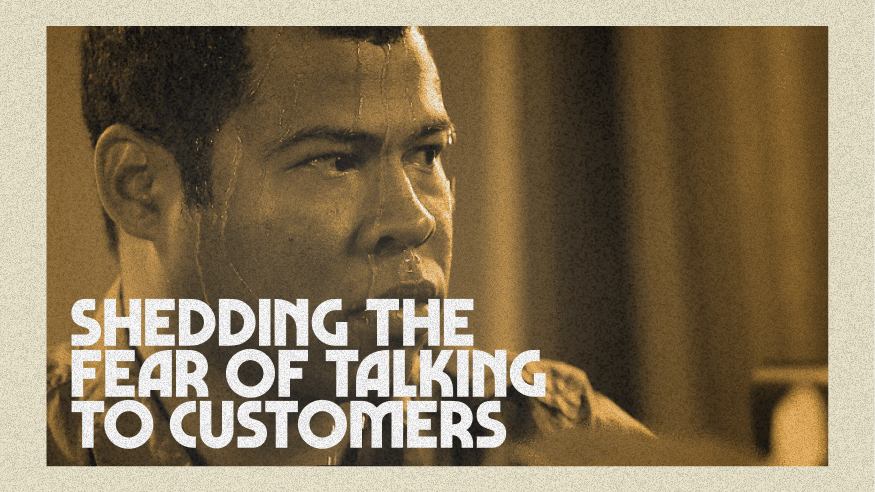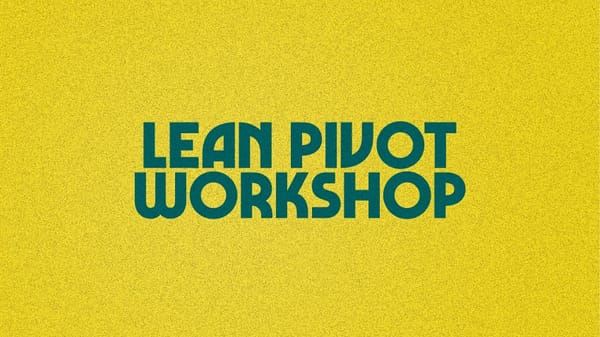How to shed the fear of talking to customers

I started learning design and strategy to get people to buy and use the projects I had spent months coding.
Thanks to my extroverted co-founder, Mayun, I had the opportunity to approach anyone and showcase a prototype.
It made it easy for me as an introvert.
Talking to people used to drain my energy. The mere thought of talking to people would send me into a panic.
I’d find any excuse to avoid the situation entirely to escape the fear.
I felt like I was bothering people, and the idea of having my ideas scrutinized was equally paralyzing.
This fear of talking to customers was holding me back professionally.
It meant I was always focused on and doing the non-customer-related stuff, like coding.
As Peter Reinhardt, the former CEO of Segment, once said: “As engineers who had never done this before, talking to people didn’t seem like real work. Real work was coding. But in reality, 20 hours of great interviews probably would’ve saved us an accrued 18 months of building useless stuff.”
I was falling into the same trap, prioritizing the comfortable work while neglecting the crucial task of gathering customer feedback.
As a result, the feedback loop in my side projects and MVPs was always slow or broken.
I remember one instance where I had to manage a workshop for an 8-person team of strangers.
The night before, my anxiety was so intense that I couldn’t sleep. I tossed and turned, imagining how I could embarrass myself or fail to engage the participants.
My comfort zone was sitting next to Mayun and actively listening to users. I was an ace at it.
However, when our business closed and I parted ways with my co-founder, I realized I couldn’t rely on him. Losing my co-founder felt like losing my safety net.
I had grown accustomed to relying on Mayun’s extroverted nature, and now I had to learn to walk the tightrope of customer interactions alone.
Bidding farewell to my co-founder, I couldn’t help but imagine a tiny, pessimistic version of myself perched on my shoulder, whispering all the ways I might stumble and fall without my safety net.
I knew I had to learn this skill, but the thought of doing so was overwhelming.
It wasn’t easy, and I was filled with self-doubt and hesitation. But I figured it out by taking some baby steps.
I went from being someone who couldn’t even fathom talking to customers to becoming Shavin “How to talk to humans” Peiries, as my boss calls me:

In this article, I’ll share the three baby steps that helped me shed my fear and embrace how powerful talking to customers can be.
Baby Step 1: Shifting Your Mindset From Problem to Problem-Solver
One of the most significant breakthroughs in overcoming my fear of talking to customers was realizing that I had the potential to make their lives easier by solving a problem they were facing.
Although it’s easy to fall into the trap of thinking that you’re bothering people when you reach out to them, the truth is, if you have a solution to their problem, you’re doing them a disservice by not sharing it.
Imagine your potential customers facing a challenge that consumes their thoughts and hinders their progress, missing out on opportunities and struggling to find a way forward.
Not reaching out to them means you’re withholding the solution they may need.
Now, picture yourself as someone who deeply understands their pain points and has the knowledge and expertise to guide them to a better future.
By shifting your mindset from “I’m intruding” to “I’m helping,” you can approach conversations with renewed confidence and empathy.
Your goal is not just to pitch your ideas but to understand their needs.
Think about it this way: if you were a doctor with a cure for people's illnesses, wouldn’t you feel compelled to help them?
If you’re wrong, the worst that could happen is that you find out they don’t care about this, and you would’ve saved months of work, just like Peter Reinhardt did.
I wrote, “I love talking to customers because I can uncover and solve their problems,” on a post-it note and placed it on my bathroom mirror to help reinforce and shift my mindset.
Every day I saw the note, it reminded me of the new positive shift from “I don’t want to bother people” to “I have the power to make a difference,” which helped me approach conversations with calm confidence.
Baby Step 2: Learn the Switch Interview Technique
Knowing where to begin when you're starting to talk to customers about their challenges and needs can be daunting.
You may face challenges such as:
- Not knowing what questions to ask
- Difficulty interpreting their feedback
- Overcoming your biases and assumptions
- Staying focused and organized through the interview process
The Switch Interview technique, developed by Bob Moesta from the Rewired Group, can help overcome these challenges.
The method is a guideline for structuring your conversations and uncovering valuable insights.
I discovered the power of the Switch Interview technique through a video featuring Bob Moesta and Chris Spiek.
They explain its value and include a mock interview with an audience member about his journey to purchase a car for his family (minute 18).
This video made me a believer and helped me understand why this approach best fits me.
The Switch Interview technique focuses on understanding the customer's journey, key moments, and forces that led them to change or adopt a new solution.
By using this technique as a conversation guide, you can:
- Feel more prepared and confident when approaching customer conversations
- Ask meaningful questions that encourage customers to share their stories and experiences
- Uncover the underlying motivations and struggling moments that drive their behavior
When you're just starting, the specific details of the Switch Interview technique are less important than using it as a tool to guide your conversations.
By having a structure to follow, you can focus on actively listening to your customers and learning from their experiences rather than getting caught up in the fear of not knowing what to say or ask.
As you become more comfortable talking to customers, you can explore the specifics of the Switch Interview technique and adapt it to your needs.
But in the beginning, simply using it as a conversation guide can be a powerful way to overcome your initial fears and start building momentum.
Get My Switch Interview Guideline
Overall Goals of the Switch Interview:
- What was the journey they went through?
- How did they discover the product?
- What prompted them to switch from one provider/tool/process to the new one?
- So far, are they satisfied with that decision?
Introduction:
- Introduce yourself and express gratitude for their time and willingness to share their story.
- Explain the purpose of the interview: to understand their journey and decision-making process when choosing [product].
- Tell them there are no right or wrong answers, and you're just here to listen to their story.
- If it helps, get them to think you're filming a documentary about their life and they're helping you fill in the details.
Questions:
Purchase Details:
- When did you make the purchase for [product]?
- Where were you when you made the purchase?
- What time of day was it? (daytime/nighttime?)
- What was the weather like that day?
- Was anyone else with you at the time of the purchase?
- How did you go about purchasing the product? (online, in-store, etc.)
Guideline: These questions help to establish the context and anchor the interviewee's memory to the specific moment of the purchase. By asking about the details surrounding the purchase, you can help them better recall their thoughts, feelings, and motivations at that specific moment.
Initial Thought (Push):
- If you could go back, when did you first start thinking about purchasing a solution like [product]?
- What challenges or frustrations were you experiencing that led you to consider a new solution?
- How were these issues affecting your work or your organization?
Guideline: The 'Push' questions aim to uncover the pain points, challenges, or dissatisfactions that initially prompted the interviewee to start seeking a new solution. Understanding these factors helps to identify the underlying context and motivations that drove them to find a new way to progress.
Attraction to the New Solution (Pull):
- How did you discover the [product]?
- What aspects appealed to you most when you first learned about [product]?
- How did you envision [product] helping to address the challenges you were facing?
- What specific features or capabilities of [product] stood out to you as particularly valuable?
Guideline: The 'Pull' questions focus on the attractive aspects of the new solution that drew the interviewee towards it. These questions help to identify the key selling points and value propositions that resonated with the customer and influenced their decision to adopt the product.
Hesitations and Concerns (Anxieties):
- As you were evaluating [product], did you have any concerns or hesitations about adopting it?
- Were there any potential risks or drawbacks that you needed to consider?
- How did you ultimately overcome these concerns or address these potential issues?
Guideline: The 'Anxieties' questions explore any doubts, fears, or uncertainties the interviewee may have had about the new solution. Understanding these concerns helps to identify potential barriers to adoption and how the customer overcame them.
Existing Habits and Behaviors (Habits):
- Before adopting [product], what existing solutions or processes did you have in place to handle [problem]?
- How did these existing habits or behaviors influence your decision-making process?
- Did you have any concerns about how [product] would fit into your established workflow or routines?
Guideline: The 'Habits' questions to integrate into the customer's workflow seamlessly into the interviewee's existing routines, processes, and behaviors that may have influenced their decision to adopt a new solution. Understanding these habits helps identify potential barriers to change and how the product can be positioned to integrate into the customer's workflow seamlessly.
Deciding Moment:
- Can you pinpoint the moment when you finally decided to move forward with [product]?
- What specific event, realization, or piece of information pushed you to make that decision?
- Who else, if anyone, was involved in making the final decision to adopt [product]?
Guideline: The 'Deciding Moment' questions aim to identify the tipping point or catalyst that ultimately led the interviewee to choose the product. Understanding this crucial moment helps to pinpoint the key factors that drove the final decision and any important influencers or stakeholders involved in the process.
Reflection and Satisfaction:
- Now that you've been using [product] for some time, how well is it meeting your initial expectations?
- Are there any specific ways in which [product] has helped you or your organization?
- Looking back, what makes you feel confident that you made the right decision in choosing [product]?
Guideline: The 'Reflection and Satisfaction' questions provide an opportunity for the interviewee to assess their post-purchase experience and share any notable benefits or successes they've achieved with the product. These insights can help validate the product's value proposition and identify areas for improvement or potential case studies.
Closing:
- Thank the interviewee for their time and valuable insights.
- Ask if there's anything else they'd like to share about their experience or if they have any questions for you.
- If you’ve offered an incentive of any sort, acknowledge it now and how they will receive it.
Additional notes:
- From the get-go, make it as conversational as possible, so it's less like interviewing someone for a job role but rather more like catching up with an old friend.
- It's okay if you jump around to different parts of the timeline during the interview. To make the interviewee feel comfortable, validate their responses by saying something like, "I know I'm jumping around here, but [ask your question]."
- If the interviewee seems hesitant or uncertain about a particular question, reassure them that there are no wrong answers and that you're simply interested in their honest experience.
- Be prepared to ask follow-up questions based on the interviewee's responses to gain deeper insights into their decision-making process and the factors that influenced their choice, especially if it’s something obvious. Words like fast and easy are relative. Faster than what? Easier than what?
- If the interviewee mentions something interesting or unexpected, don't be afraid to deviate from the guideline to explore that topic further.
- Remember to practice active listening throughout the interview. Give the interviewee your full attention and show genuine interest in their story. They should be talking 80% of the time.
- If the interviewee seems to be rushing through their answers, slow down the pace of the interview by asking them to elaborate on specific points or by rephrasing questions to encourage detailed responses by asking what they meant by them.
- Before wrapping up the interview, make sure you have addressed the four key areas: Push (what prompted them to seek a new solution), Pull (what attracted them to the new product), Anxieties (what concerns or hesitations they had), and Habits (how their existing behaviors influenced their decision). If any of these areas haven't been fully explored, ask additional questions to ensure you have a comprehensive understanding of their decision-making process.
- Keep a pen and paper next to you to jot down ideas as the interview progresses. Since the interview is not linear, you can jot down quotes the interviewee says that you can clarify with them as the interview progresses.
Baby Step 3: Practicing Interviews About Recent Purchases
When I consciously decided to stop getting in the way of growing my ideas, I didn't start by immediately approaching potential customers.
Instead, I focused on creating a low-stakes playground where I could practice talking to people and getting their stories behind their purchasing decisions.
I didn't want to put my products and services on the spot immediately. Nobody wants to hear that their baby is ugly.
I just wanted to start practicing in a more comfortable setting.
This way, when it was time to approach a real potential customer, I would feel less intimidated and more prepared.
To get started, consider practicing interviews with friends, family, or colleagues about their recent purchases.
This low-pressure environment allows you to:
- Get comfortable with the process of conducting interviews
- Practice active listening and asking follow-up questions
- Build confidence in your ability to have meaningful conversations
When conducting these practice interviews, focus on purchases that require some level of consideration or research, such as a new phone, a vacation package, or an educational course. Don’t ask them about their impulse ice cream purchase.
Your Action Plan: Shed the Fear of Talking to Customers
To recap:
- Identify your biggest fear or objection when it comes to talking to customers.
- Reframe it as an opportunity to help, and write it down on a post-it note. For example, "I love talking to customers because I can uncover and solve a problem that's been bothering them."
- Stick the Post-it note on your bathroom mirror and remind yourself of this new mindset daily.
- Practice the Switch Interview technique by conducting low-stakes interviews with friends or family about their recent purchases.
Here's how to get started:
- Make a list of 10 friends who you know will be open to helping you out.
- Ask them to take part using this sample message:
Sample message to recruit your friends for an interview
Hey dude!
BIG FAVOUR TO ASK 🙏🏾
I've been working on upping my interviewing skills and I could really use your help. Remember when you bought that [item purchased]? I'm super curious to hear about what made you choose it and how you went about the whole buying process.
If you're down for it, I was hoping we could jump on a quick call sometime soon, totally at your convenience. It would be incredible practice for me.
To sweeten the deal, let me treat you to a coffee or lunch later 😉
No pressure if you can't make it work, but if you're up for sharing your story, I'd be insanely grateful.
Just let me know what times might be good for you!
- Before the call:
- Schedule a meeting with them using your preferred calendar tool, making sure you find a time that works well for both of you.
- Set up a meeting recorder like Fathom (I use this, and it's free) so you can focus on actively listening and asking questions rather than taking a lot of notes.
- Review the Switch Interview technique and prepare a loose outline of the questions you want to ask, focusing on the key moments in their purchase journey. Adjust it for your context.
- During the call, focus on actively listening and asking follow-up questions to uncover insights about their purchase journey. Use the switch interview guideline.
- After the call, reflect on what you learned and how you can apply those lessons to future customer conversations.
- Set a goal to conduct at least two practice interviews per week and gradually increase the stakes as you build confidence.
Conquering the fear of talking to customers starts with small, manageable steps.
By shifting your mindset, learning the Switch Interview technique, and practicing in low-stakes situations, you can gradually build the confidence and skills needed to have meaningful conversations with your own customers.
Remember, every conversation is an opportunity to learn and grow.
So, take that first step today and start unlocking your full potential.
For more insights and strategies to help you succeed, check out my other posts on:





